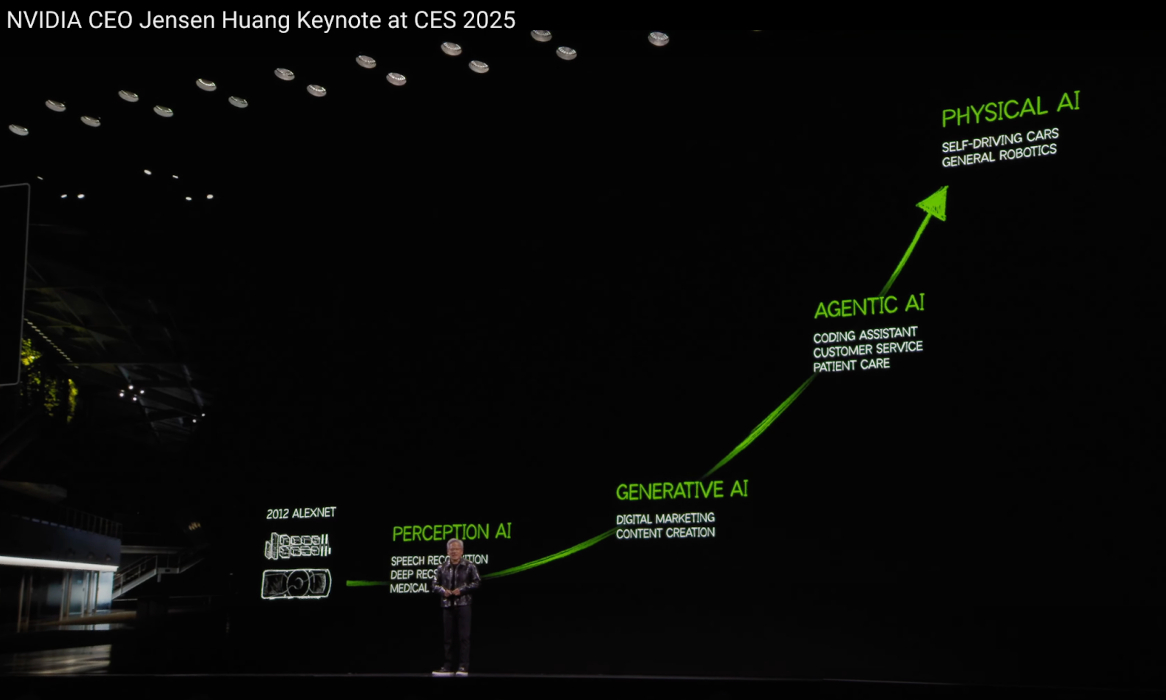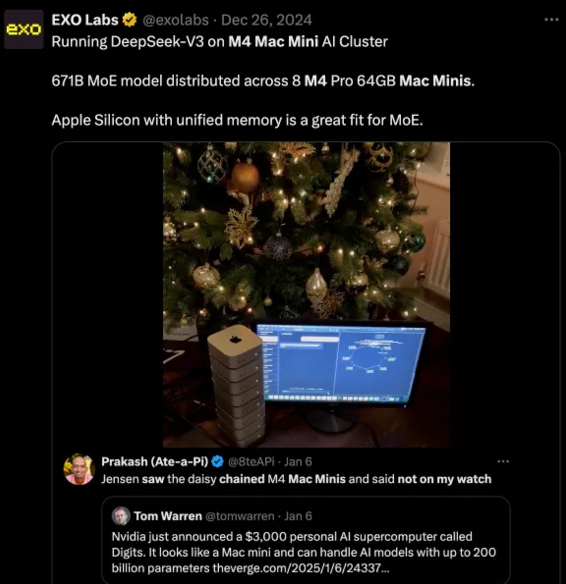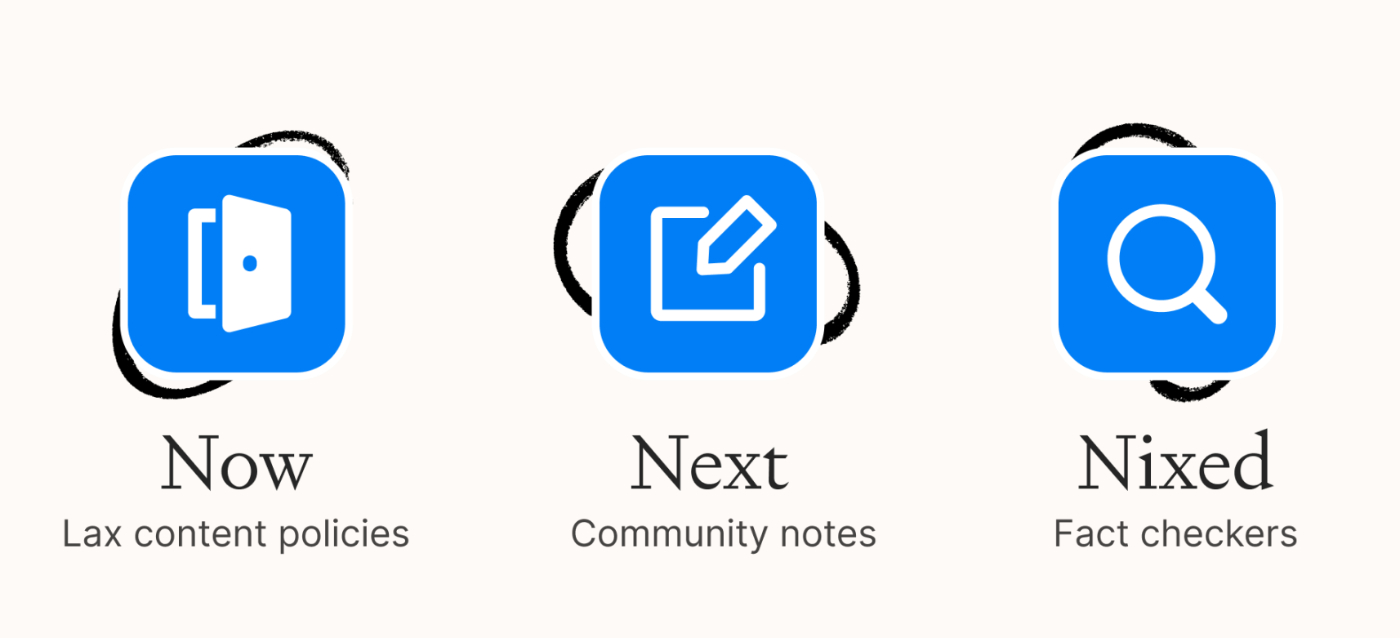
Hello, and happy Sunday! Nvidia CEO Jensen Huang kicked off the new year—and CES—in style with a keynote address in which he laid out his vision for the future of artificial intelligence. Scroll down for Alex Duffy’s analysis of the chipmaking giant’s big plans for 2025, and everything we wrote this week at Every.—Kate Lee
Was this newsletter forwarded to you? Sign up to get it in your inbox.
Release notes
Nvidia’s vision: Agents, cars, robots, and personal supercomputers
At the Consumer Electronics Show (CES) earlier this week, Nvidia CEO Jensen Huang laid out a vision in which AI isn't just generating content in the cloud—it's running privately on your own devices, driving your car, and, eventually, powering general-purpose robots that could transform manual labor as we know it.
With revenue that could hit $200 billion next year, up from $27 billion just two years ago, Nvidia is betting on AI evolving beyond being a tool for generating content to agents that can take action and create value autonomously.
What’s new:
- AI-powered graphics cards: Next-generation RTX cards that use AI to generate extra frames for smoother gaming and more power for consumers
- A personal AI supercomputer: Project DIGITS, a $3,000 Mac Mini-sized AI supercomputer powerful enough for developers and creators to run or train their own AI models without the need for a cloud
- A world simulation platform: Cosmos, an open-source system for training robots in virtual worlds before real-world deployment
- A self-driving partnership: Toyota has chosen Nvidia’s car computer and safety-certified operating system; Mercedes-Benz and Volvo are already using its autonomous driving platform
- New manufacturing partnerships: Nvidia is working with the German manufacturer Kion on warehouse automation and the consulting firm Accenture to create virtual representations of facilities or products called digital twins that can be optimized
- Digital characters: New tools for creating AI-powered game characters
Why these releases?
AI gets better the more it knows about you. Currently you need to send all your personal data to the cloud in order to get personalized responses, and each query costs you. The more AI gets integrated into devices like your computer and phone, you pay for nothing but power, so the more value it can provide.
But with agents, self-driving cars, and robotics becoming a reality, a new suite of tools is needed.
Huang’s vision for the past, present, and future of AI
Jensen believes we’re currently in AI’s agentic age, and that we’ll soon be entering the age of physical AI. He laid out a vision for the past and future of AI that moves along four phases:
- Perception AI: Understanding our world (2012–2020)
- Generative AI: Creating content (2021–2023)
- Agentic AI: Taking autonomous action (2025)
- Physical AI: Manipulating the real world (the future)
Through the gold rushes of perception (like social media) and generative AI, Nvidia has been selling the picks and shovels—namely, its GPU chips and proprietary Compute Unified Device Architecture (CUDA) software. The latter only runs on its chips but makes AI training and inference dramatically faster than alternatives. Nvidia has secured 90 percent of the global GPU market share, and this near-monopoly has put it neck-and-neck with Apple for the honors of the world's most valuable company.
Nvidia believes that AI has only just gotten started, and it needs a lot more power.
The AI factory
Going from generative AI to agentic and physical AI requires massive computing power. Nvidia’s solution is “AI factories,” massive data centers filled with specialized chips designed to generate AI tokens (read: words) as efficiently as possible. The newest chip powering these factories, Blackwell, is four times more energy efficient than its predecessor and enables the training of models three times the size for the same cost.
Source: X/EXO Labs and Prakash Narayanan.Your personal AI
AI is most valuable when it is seamlessly integrated into existing tools and has access to your data (as opposed to remaining in the cloud), and the more it costs, the fewer people will use it. Running AI locally on your own devices solves all of these problems and—once purchased—costs nothing but the power to run. However, most useful AI models require more processing power than is readily available. That’s why Nvidia’s DIGITS personal AI supercomputer is worth getting excited about, even if infrastructure experts have raised valid questions about its practical capabilities.
Apple Intelligence is also all about on-device AI, and the company is incredibly well positioned to execute on it. Apple has been designing its own chips since 2010, but since the launch of its M series chip in 2020, it has become one of the only legitimate Nvidia competitors in the consumer GPU market. So far, Apple Intelligence is mostly gimmicks like “genmojis” and botched summaries. However, with the amount of data flowing through our phones and computers, local AI that knows everything about you and can process it securely is inevitable. The only question is who will deliver it first.
Three potential world-changing applications
With enough processing power, Nvidia sees three main ways AI will reshape our world:
- Digital workers: AI agents will be able to handle complex knowledge work. While the hype is strong, Simon Willison—creator of some of the most widely used web frameworks—makes a compelling case that true general agents are still far off, though specialized assistants for coding and research are already proving valuable.
- Self-driving cars: This is already real. Alphabet’s Waymo is deploying 150,000 robotaxi rides weekly, Toyota recently partnered with Nvidia to build its next-gen autonomous vehicles, and Uber is leveraging the company’s world simulation platform Cosmos to work toward self-driving.
- General robotics: Nvidia claims that "the ChatGPT moment for robotics is around the corner" thanks to its new Cosmos platform for training robots in virtual worlds before deploying them in reality. This training method, called Sim2Real learning, is extremely powerful and was only possible for the first time in 2017. With these capabilities and new platforms like Cosmos, robots that change the global landscape of manual labor are coming, but you probably won't have one at home to help with the dishes this year. As we have learned repeatedly, atoms move slower than bits.
What this means for you
Nvidia is painting an ambitious portrait of the AI-enabled future. We recommend you give this vision of AI a try: Talk with ChatGPT’s advanced voice mode, experiment with Nvidia’s NIMs for tasks such as deepfake detection and weather prediction, and check out world simulation models such as Cosmos, Google’s Genie 2, and Decart’s Oasis.
Nvidia is building the foundation for AI to move beyond generating content to taking action in the digital world—and soon the physical one. While some claims deserve skepticism, the company’s track record and market position make it worth watching closely.—Alex Duffy
Now, next, nixed
The current state of content moderation on Meta’s platforms.
Source: Every illustration.
Knowledge base
If you prefer to listen to rather than read our stories, we’re live on ElevenLabs’s ElevenReader app. Download the app and subscribe to our feed to listen to audio versions of our essays voiced by AI.
“More Output, Less Effort" by Evan Armstrong/Napkin Math: Fresh off paternity leave and drowning in responsibilities, Evan has systematically revamped his personal tech stack. Over the course of six months, he tripled his writing output, read 42 books, watched 67 movies, and got a nicer butt—all while preparing for a newborn. Read this for a curated list of apps that will help you do much more while trying much less.
“Freeform: A New Experiment From Every Studio” by Cassius Kiani/Source Code: Every Studio's latest experiment, Freeform, uses AI to create forms for questions that evolve with your answers. With Freeform, entrepreneur in residence Cassius Kiani is putting the tool before the technology, something he’s learned to do the hard way from the worlds of DAOs, legal tech, and healthcare. Read this if you want to learn to find the right problems in the possibility haystack. Try Freeform and get your Every archetype for 2024.
"The New Science of Growth Marketing" by Josh Payne/Thesis: Algorithms transformed stock trading from an art to a science for Wall Street bankers back in the 1980s. Today, AI is ushering in an era of “quant experimentation” for growth marketers—leveraging data-driven decision making to scale intuition. Read this if you’re looking to bridge your gut instincts with datapoints.
“The Second Brain of a CEO Whisperer” by Scott Nover/Superorganizers: When former Holloway CEO Andy Sparks first shared his Notion set up with us back in 2019, he was building an operating system for work. Today, as an executive coach to 15 CEOs, he’s using Notion even more—only now it’s personal, too. His library is an interconnected database of topic-specific roll-ups like meeting notes, client calls, and content references. Read this if you’re eager to build your own second brain that evolves alongside your career.
"What Happens When AI Joins the Org Chart" by Katie Parrott/Working Overtime: AI isn’t just entering the workforce—it may be vying for the corner office. How do we keep up with teammates who never eat or sleep? And who’s accountable for a rogue AI employee? Read this if you’re curious about the future of collaboration with coworkers both organic and artificial.—Aleena Vigoda
From Every Studio
What we shipped this week
Our latest experiment, Freeform. Freeform is an AI-powered version of Typeform, with questions that evolve alongside your answers. Built by entrepreneur in residence Cassius Kiani, Freeform lets you set goals on the forms you create—like determining product-market-fit in a user-research survey—which influences how the form dynamically adapts with each response. Discover your Every archetype for 2024 with Freeform.
Cora update: Three weeks into launching Cora, our reimagined email experience, our waitlist is 7,600 users strong. Here’s what we’ve learned so far from our earliest users’ feedback:
- The stickiest products tend to be polarizing: Either you’re all in on the app or you don’t use it at all. Every head of Studio Brandon Gell shared some of our numbers, which reveal that email open rates are either 100 percent or zero.
- People want to bridge their personal and professional lives: The most common feature request is to combine separate email accounts into one brief and be able to seamlessly switch between separate accounts.
- Email is confusing, and users are eager for more automation: Our most compelling value proposition to users (like business writer Adam Davidson) is that Cora offers a new methodology that changes consumer habits around email.
We’re prioritizing onboarding Every subscribers, so subscribe to Every to jump the waitlist. You can also follow product updates on our changelog, leave feedback or feature requests, and preview the Cora roadmap.—AV
Alignment
Truth needs likes. Meta's plan to scale back third-party fact-checking in favor of community-driven moderation amplifies the risk that harmful health misinformation will spread unchecked. By removing an expert-verified failsafe, the company’s executives are betting that a broad user base—one without medical training—will catch and correct false claims. In fast-moving online discussions, these corrections will lag behind initial exposures. A 2023 poll from health policy nonprofit KFF revealed that 14 percent of all Americans had come across—and ultimately believed—the false statement that more people died from COVID-19 vaccines than from the virus itself.” Under Meta's new policy, by the time a critical mass of users flags such a claim as false, millions of people will have already absorbed it as truth. Or as Mark Twain put it, “A lie can travel halfway around the world while the truth is putting on its shoes.” And in Meta's new world, the truth now needs a crowd to agree whether it's wearing shoes at all.—Ashwin Sharma
Hallucination
What if minimalism hadn’t removed the soul from the technology we use every day?
Source: X/Lucas CrespoThat’s all for this week! Be sure to follow Every on X at @every and on LinkedIn.
We also build AI tools for readers like you. Automate repeat writing with Spiral. Organize files automatically with Sparkle. Write something great with Lex.
Get paid for sharing Every with your friends. Join our referral program.
The Only Subscription
You Need to
Stay at the
Edge of AI
The essential toolkit for those shaping the future
"This might be the best value you
can get from an AI subscription."
- Jay S.
Join 100,000+ leaders, builders, and innovators

Email address
Already have an account? Sign in
What is included in a subscription?
Daily insights from AI pioneers + early access to powerful AI tools










.png)
.png)
.png)
Comments
Don't have an account? Sign up!